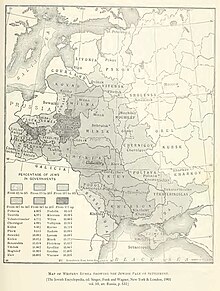
Back Vestigingsgebied Afrikaans Ansiedlungsrayon ALS نطاق الاستيطان Arabic Zona d'Asentamientu AST Мяжа аселасці Byelorussian Мяжа аселасьці BE-X-OLD Линия на уседналост Bulgarian Demarcació jueva Catalan Zóna osídlení Czech Pâl gwladychiad Welsh
| Pale of Settlement Черта осѣдлости | |
|---|---|
| 1791–1915 | |
 Jews in the governorates of the Pale of Settlement by percent. Note that all references to governments actually are to governorates. | |
| Historical era | 124 years: From the late 18th to early 20th centuries |
• Established | 1791 |
• Disestablished | 1915 |
| Today part of | 7 countries: Belarus, Lithuania, Moldova, Ukraine, Poland, Latvia and Russia. |
The Pale of Settlement[a] was a western region of the Russian Empire with varying borders that existed from 1791 to 1917 (de facto until 1915) in which permanent residency by Jews was allowed and beyond which Jewish residency, permanent or temporary,[1] was mostly forbidden. Most Jews were still excluded from residency in a number of cities within the Pale as well. A few Jews were allowed to live outside the area, including those with university education, the ennobled, members of the most affluent of the merchant guilds and particular artisans, some military personnel and some services associated with them, including their families, and sometimes their servants. The archaic English term pale is derived from the Latin word palus, a stake, extended to mean the area enclosed by a fence or boundary.[2]
The Pale of Settlement included all of modern-day Belarus and Moldova, much of Lithuania, Ukraine and east-central Poland, and relatively small parts of Latvia and what is now the western Russian Federation. It extended from the eastern pale, or demarcation line inside the country, westwards to the Imperial Russian border with the Kingdom of Prussia (later the German Empire) and Austria-Hungary. Furthermore, it comprised about 20% of the territory of European Russia and largely corresponded to historical lands of the former Polish–Lithuanian Commonwealth, Cossack Hetmanate, the Ottoman Empire (with Yedisan), Crimean Khanate, and eastern Principality of Moldavia (Bessarabia).
Life in the Pale for many was economically bleak. Most people relied on small service or artisan work that could not support the number of inhabitants, which resulted in emigration, especially in the late 19th century. Even so, Jewish culture, especially in Yiddish, developed in the shtetls (small towns), and intellectual culture developed in the yeshivot (religious schools) and was also carried abroad.
The Russian Empire during the existence of the Pale was predominantly Orthodox Christian, in contrast to the area included in the Pale with its large minorities of Jewish, Roman Catholic and until mid-19th century Eastern Catholic population (although much of modern Ukraine, Belarus and Moldova are predominantly Eastern Orthodox). While the religious nature of the edicts creating the Pale is clear (conversion to Russian Orthodoxy, the state religion, released individuals from the strictures), historians argue that the motivations for its creation and maintenance were primarily economic and nationalist in nature.
The end of the enforcement and formal demarcation of the Pale coincided with the beginning of World War I in 1914, when large numbers of Jews fled into the Russian interior to escape the invading German army, and then ultimately in 1917 with the end of the Russian Empire as a result of the February Revolution.[3][4]
Cite error: There are <ref group=lower-alpha> tags or {{efn}} templates on this page, but the references will not show without a {{reflist|group=lower-alpha}} template or {{notelist}} template (see the help page).
- ^ Черта оседлости. (tr. "Settlement line") KEE, volume 9, col. 1188–1198 eleven.co.il
- ^ "pale, n.1." OED Online. Oxford University Press, September 2016. Retrieved October 24, 2016. The Pale was the part of medieval Ireland controlled by the English government.
- ^ Сборник важнейших законоположений и распоряжений, действующих с 1 июля 1914 по 1 января 1916 года, вызванных обстоятельствами военного времени. Пг. 1916. p. 73. ISBN 978-5-4460-6984-2.
{{cite book}}: CS1 maint: location missing publisher (link) - ^ Аронсон Г. Я. В борьбе за гражданские и национальные права: Общественные течения в русском еврействе // КРЕ-1. — С. 232.
© MMXXIII Rich X Search. We shall prevail. All rights reserved. Rich X Search